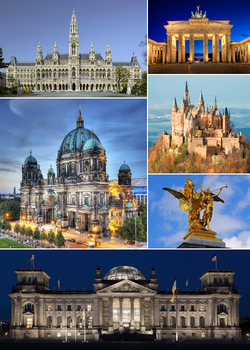Königsreh
This article is incomplete because it is pending further input from participants, or it is a work-in-progress by one author. Please comment on this article's talk page to share your input, comments and questions. Note: To contribute to this article, you may need to seek help from the author(s) of this page. |
Königsreh | |
|---|---|
Capital City | |
 Clockwise from top right: Victory Gate, the Hochkronstein, Reichsrat, Skyline of central Königsreh, St.Lorenz Cathedral, Royal Palace | |
| Nickname: The Gold City | |
| Motto: "Unser ist die Krone" ("Ours is the Crown") | |
| File:Kin.png | |
| Heighder | 2 April 1797 |
| Founded by | Robert I. |
| Seat | Red Castle (Rotburgfried) |
| Government | |
| • Mayor | Paul Choldwig (NDU) |
| Area | |
| • Water | 9.6 km2 (3.7 sq mi) |
| Population (2018) | |
| • Capital City | 1,231,326 |
| • Urban | 2,311,177 |
| • Metro | 4,009,486 |
| Demonym(s) | Königsreher (m), Königsreherin (f) |
| Time zone | MEAT (UTC+2) |
Königsreh (Alemannic pronunciation: [ˈkøːnɪçsˌreh]) is the capital and second largest city of Mascylla by both are and population. Its 1,231,326 (2017) inhabitants make it one of the largest most populous city propers in Alemannia after Sigairen, Ulskach, and Flussmund. The city is one of Mascylla's 18 principalities, nmed the Kronlande, and it is surrounded by the states of Eystrun and Nelgern, the capitals of which, Lehpold and Mündkeld, are contiguous with Königsreh. The three cities are at the centre of the Eystrun/Kronlande Metropolitan Region, which is, with 2,3 million inhabitants, Mascylla's third largest metropolitan region after the Blaugold-Edward and Kreschitien regions. Königsreh straddles the banks of the River Blaugold, which flows into the Kaphel Lake in the eastern borough of Mehlau, where it leaves it again, facing the Edward's Bay. Among the cvity's main topographical features are the many smaller rivers in the western and southern boroughs, all leading to the Blaugold, the largest of which is the Weider River. Due to tis location in the Midcentral Mascyllary Plain, Königsreh is influenced by a temperate seasonal climate. About one third of the city's area is composed of forests, parks, rivers,m canals, and lakes. The city lies in the Centra Mascyllary dialect area, the Königsreh dialect being a variant of it.
First documented in the 13th century and situated at the crossing of two important trade routes, the village in the past known as Schwülpt, became a minor political location and population centre. Its major importance was archieved through the foundation of the city of Königsreh by King Lukas I himself, after a fitting spot for a national capital was searched for. Königsreh quickly evolved into a large metropolitan area, the fourth largest one in Alemannia in the 1920s. The city served as the capital of the Kingdom of Mascylla (1793-1942), the Mascyllary Republic (1942-1944), and the Crowned Republic of Mascylla until today.
Königsreh is an internationally recognised city of culture, politics, media and science. Its economy is based on high-tech firms and the service sector, encompassing a diverse range of creative industries, research facilities, media corporations and convention venues. Königsreh serves as a multinational hub for air and rail traffic and has a complex public transportation network. The metropolis is a popular tourist destination. Significant industries also include IT, pharmaceuticals, biomedical engineering, clean tech, biotechnology, construction and electronics. Königsreh is home to world-renowned universities, orchestras, museums, and entertainment venues, and is host to many sporting events. Its Zoological Garden is one of the most visited zoo in Alemannia and one of the most popular worldwide. With one of the world's oldest large-scale movie studio complexes, Königsreh is an increasingly popular location for international film productions. The city is well known for its festivals, diverse architecture, nightlife, contemporary arts and a very high quality of living. Since the 2000s Königsreh has seen the emergence of a cosmopolitan entrepreneurial scene.

